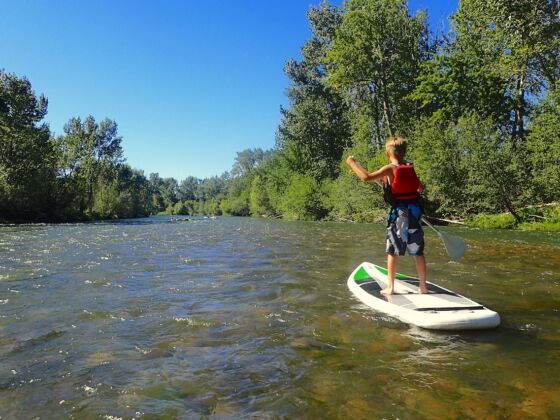THE FIRST TIME I floated downstream, right through downtown, reminded me how important this river is to the city: festivals have been created to celebrate it; French trappers and Captain Bonneville flipped out upon seeing this tree-lined body of water in the middle of all the dirt and sagebrush; and even Matisyahu was spotted floating by last year.

Follow these rules for safety.
Before you throw any old pool toy into the water, there are a few rules:
- Do not float the river before it officially opens! The water will be too high, and fallen trees and debris have yet to be cleared. It typically opens late June or early July, so be patient and check online for the official announcement.
- Alcohol was outlawed in 2005, so you can’t bring a six-pack along anymore. Save it for the traditional post-float barbecue.
- Wear a life vest, especially if you’re not a strong swimmer. (Kids should always wear a life vest.) It’ll give you peace of mind while going over the diversion weirs, and the last place you want to be if you can’t swim is in a river filled with drunk people (see rule above), especially if your tube pops.
Where to put-in and how to acquire your floatation device.
Put-in (start) at Barber Park, about 20 minutes east of downtown. Turn on Eckert Rd. (a right off Warm Springs or a left off Boise Ave. — both routes are popular) and follow it until you see the park.
At the start, Epley’s Boise River Rentals rents tubes and rafts for $12-$55 for three hours, and has free air stations if you’ve brought your own. The river water is shallow here, so maneuver your flotation device and hop in.
Stay afloat and watch for weirs.
Shortly after the start, an island splits the waterway. Stay to the left, as the right fork is much narrower and may not keep you afloat.
Keep the tube steady when you reach diversion weirs, mini-waterfalls that try to topple you out of your tube. It’s a mix of instinct and keeping the front of the raft or tube up.
I just learned to swim the day before my first float, and kept watching the little white dog on the raft ahead of me (pets are okay, if they have a lifejacket). She was shifting her center of gravity for each weir, and I remember thinking, “If she can do it without falling off, so can I.”
Enjoy the leisurely ride.
The first two miles are a chance to enjoy the 90° F sunshine and the views: sagebrush-covered foothills of the Rockies to the right, creepy giant herons’ nests high in the trees to the left. The foothills give way to a golf course, where floater rest stops are an opportunity to throw away trash or use the restroom.
Steer left when you see the bright orange bridge, unless you enjoy getting soaked by the rowdy college kids cannonballing next to you.
Then begins the “Ribbon of Jewels” — city parks honoring famous local women. The first is Municipal (not named after a woman), the former “hobo jungle” (named for the unemployed workers during the Depression). The riverbanks here are full of geese, loons, and two types of mallards. Floating before noon or early in the evening increases chances of muskrat, fox, and doe with fawn sightings.
Floating under the Broadway Bridge gets you into Julia Davis Park, the oldest park in Boise. A former orchard named after one of the original citizens, it holds several museums and Zoo Boise. Quickly look to the right just past the Friendship Bridge to catch a glimpse of Julius the Giraffe eating some leaves.
Boise State University is on the opposite bank. If you’re floating around noon on a weekday, there’s a good chance the marching band is practicing on the famous Smurf Turf.
There are small islands in the river here, and the more adventurous go to the right, which has less room to avoid branches and leaves. I stay left to avoid getting stuck or, worse, pulled under.
Make sure you get out before the diversion dam.
Once you’ve cleared the island and are floating under the old wood-and-iron railroad bridge, start shifting to the left. This is Ann Morrison Park, named after “The First Lady of Construction” — the wife of Henry Morrison, builder of the Hoover Dam and Kennedy Space Center.
There are two docks to the left, located on each side of the footbridge. You must take out here — a dangerous diversion dam is ahead, and people have drowned floating unsanctioned sections.
Reward yourself heartily.
Epley’s has a rental return point in Ann Morrison, and runs a $3 shuttle bus that can take floaters back to the start at Barber Park.
If you came with me, though, you’d have already parked a car full of coolers and barbecue supplies at Ann Morrison, and used the shuttle bus to get to the start in the first place. This means we’ll be immediately starting up the grill and refreshing our sun-drained selves at the finish.
Food always seems to taste better in a swimsuit, doesn’t it?